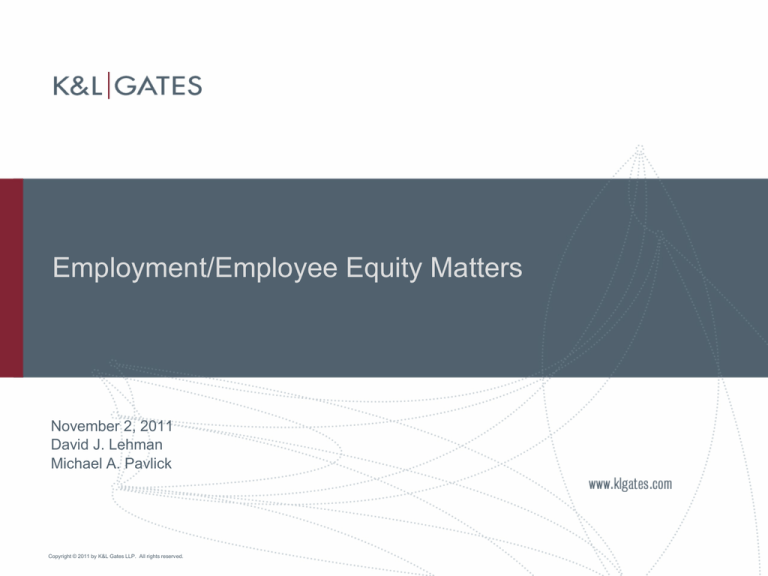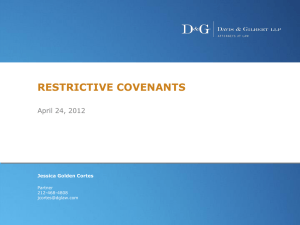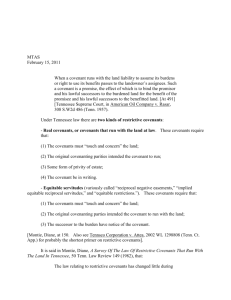
Employment/Employee Equity Matters
November 2, 2011
David J. Lehman
Michael A. Pavlick
Copyright © 2011 by K&L Gates LLP. All rights reserved.
Agenda
Introduction
Independent Contractors v. Employees
Terms of Employment Relationship/Covenants
Employee Equity
IPI Clinic
Introduction to Contracts
Independent Contractor Agreement
Questions and Answers
1
Contractor v Employee: Why Does It Matter?
Statutes often only apply to employees, not
contractors, owners, partners.
Misclassification is more common than you might
think (NY study: 10% of all private-sector workers
misclassified).
Increased government attention (states have
formed task forces on the issue).
“New” economy means employers may look to
cut costs and states will aggressively pursue lost
revenues.
Litigation
2
Three Tests
Three basic tests of employee status
Right to Control (IRC, NLRA, ERISA, ADA)
Economic Reality (FLSA, SSA, FMLA)
Hybrid (Title VII, ADEA)
As a practical matter, the lines often blur between
the tests, and courts, while purporting to apply
either Right to Control or Economic Reality, often
end up utilizing a hybrid test.
3
Towards a Unified Test?
Murray v. Principal Financial Group (9th Cir. 2010)
“[T]here is no functional difference between the three
formulations.”
12 factors identified:
Skill required
Source of instrumentalities/tools
Location of work
Duration of relationship
Can hiring party assign additional projects
Hired party’s discretion over when and how long to work
Method of payment
Hired party’s role in hiring and paying assistants
Work part of regular business of hiring party
Hiring party is in business/can work elsewhere
Provision of employee benefits
Tax treatment of the hired party
4
Wage and Hour Law Principles
Minimum wage and overtime requirements
Must pay minimum wage and overtime to ALL
employees (but not independent contractors)
FLSA has numerous exemptions and exceptions
to minimum wage and overtime requirements
Most common exemptions are so-called “white
collar exemptions”
5
White Collar Exemptions
Exemptions for executive, administrative, and
professional workers
Must satisfy a minimum compensation
requirement and both a duties test and a salary
basis test
6
Executive Exemption
Must be paid $455 per week on a salary basis
Primary duty must be management
Must customarily and regularly direct 2 or more
other workers
Must have the authority to hire or fire other
employees, or make suggestions on employee
status that are given particular weight
7
Administrative Exemption
Must be paid $455 per week on a salary basis
Primary duty must be non-manual work directly
related to the management or general business
operations of the employer or the employer’s
customers
Must exercise discretion and independent
judgment with respect to matters of significance
An employee who leads a team of other
employees assigned to a major project generally
meets this requirement
8
Professional Exemption
Usually must be paid $455 per week on a salary
basis
Must be a learned professional, artistic
professional, teacher, doctor, or attorney
Learned professionals do work requiring
advanced knowledge in a field of science or
learning customarily acquired through prolonged
instruction and must consistently exercise
discretion and judgment
Creative professionals do work that is original
and creative in nature in a recognized field of
artistic endeavor
9
Minimum Compensation Requirements
Must be paid a minimum of $455 per week
($23,660 per year) on a salary basis
The minimum may not be prorated for part-time
workers
Workers who are paid $100,000 or more per year
in total compensation and who perform any one
or more exempt duties can qualify for the highly
compensated employee exemption
10
Additional Topics
Volunteers not permitted in for-profit sector
Use of volunteers permitted, but closely
regulated, in not-for-profit sector
FLSA prohibits waiver or release of claims for
unpaid wages except with the approval of a court
or Department of Labor, Wage and Hour Division
11
Employment – In General
Agreement v. No Agreement (the “Pre-Nuptual”)
Roles and responsibilities/expectations
Compensation
Base
Bonus
Expenses
Benefits
Equity (TBD)
Term and termination
At-will
Severance
Accrued Compensation (e.g., commissions)
12
Intellectual Property
Use of Third Party Confidential Information
Representation
License
Invention Assignment
Significance
Current
Prospective obligation
Definition of “Invention”
13
Restrictive Covenants
Confidentiality
Non-Competition
Non-Solicitation
Note: State laws differ
14
Restrictive Covenants (cont.)
Confidentiality
Definition of “Confidential Information”
In general
Typical exceptions
Customer confidential information
Covenants
Maintain confidentiality
Restriction on use for other purposes
Danger for Company (In general)
15
Restrictive Covenants (cont.)
Non-compete
Requirement of consideration
Length of time
Substantive scope
Geographic scope
Reasonableness
16
Restrictive Covenants (cont.)
Non-solicitation
Employees (current; former)
Customers
Current customers (note: What are current customers)
Prospective customers
Suppliers
Length of Time
17
Restrictive Covenants (cont.)
Remedies
Injunctive Relief
Extension
Buy-back stock (include in equity plan)
Collection of legal fees/costs
Forum for litigation
Arbitration v. Courts
Governing Law
18
Employee Equity – Types of equity
Restricted Stock
Options
Qualified options
Non-qualified options
Profits Interests
Phantom Equity Plans
19
Key Common Terms
Vesting
Time vesting
Performance vesting
Repurchase Right
Vested
Non-vested
Obligation to sign shareholder agreement or
similar arrangement
Restrictions on transfer
Drag-Along
20
Restricted Stock
Taxed upon receipt
Section 83 and Section 83(b) Election
Potential capital gain treatment
Current Ownership
Participate in dividends
Voting
Most useful early
Consider funding the tax liability
21
Non-Qualified Stock Options
No tax upon receipt
Taxed upon exercise at ordinary income rates
(fair market value less exercise price)
Taxed upon sale (capital gain) (sale price less
fair market value at time of exercise)
No ownership of stock until option is exercised
No participation in dividends
No voting
22
Illusive Qualified Stock Options
No tax upon receipt
No tax upon exercise (subject to alternative
minimum tax on fair market value over exercise
price)
Tax at capital gain upon sale
No ownership of stock until option is exercised
No participation in dividends
No voting
23
Restrictions for Qualified Options (among others)
Option price must be at fair market value
Must hold stock for at least one year after
exercise
Shareholder approval of plan
Employees only
Non-transferable
Must be exercised within 90 days after
termination of employment
24
Profits Interests (LLC’s and Partnerships Only)
Share in value in excess of value upon receipt
No tax upon issuance
Treated as a member (share in distributions)
Voting v. non-voting
Issue regarding employee v. partner (K-1 v. W-2)
Potentially confusing to recipients
25
Example
Assumptions:
Company initial value:
Sale at 3 years:
Employee:
$500,000
$5,000,000 valuation
1% (1,000 shares out of 100,000 shares)
Tax Rates:
Ordinary Income:
Capital gain:
40%
15%
26
Example
Restricted Stock
Tax on receipt: 40% of $5,000 = $2,000
Tax on sale: ($50,000 – $5,000) x 15% = $6,750
Proceeds to Employee:
$50,000
(2,000) initial tax
(6,750) tax on sale
$41,250
27
Example
Non-qualified Options
No tax on receipt
Exercise Price: $5,000
Tax on exercise: ($50,000 - $5,000) (.4) = $18,000
Proceeds to Employee:
$ 50,000
(5,000) exercise price
(18,000) tax
$ 27,000
28
Example
Profits Interest:
No tax on receipt
Proceeds: 1% of increase in value over $500,000
= ($5M - $500,000) x .01 = $45,000
Tax on sale ($45,000 x .15) = $6,750
Proceeds to Employee:
$45,000
(6,750) tax on sale
$38,250
29
Example
Comparison of After - Tax Proceeds
Restricted Stock:
Non-Qualified Option:
Profits Interest:
$41,250
$27,000
$38,250
30
Bottom Line on Equity
Restricted stock is best if company has low value
Profits interests are attractive if entity is a limited
liability company
Non-qualified options are an attractive vehicle
Don’t forget about 83(b) elections
31
Considerations in the Amount of Equity
The purpose is to attract and maintain talent
Think about the future
Many employees do not value equity
An option pool can be replenished
10-15% employee option pool is “standard”
A large pool may work against the Company in a
financing
32
Independent Contractor Agreement - Contracts
Contract
Read and Understand
Confirm business points
The “drafter” controls
Ask “what if’s”
Consider
Breaches
Remedies
“Who decides, who decides”
What happens while issues are being decided
33
Independent Contractor Agreement – IPI Session
Objective
Next steps
34
Questions and Answers
35











![5.3 hud [rider] [amendment] to restrictive covenants](http://s3.studylib.net/store/data/006639376_1-ecdd7cd986bfbd96b0fa6456414cef94-300x300.png)
